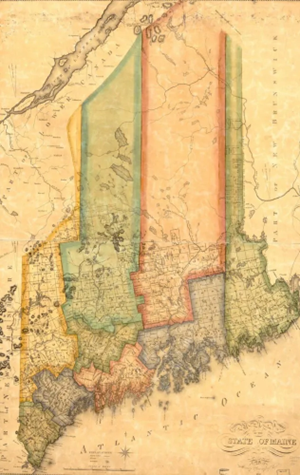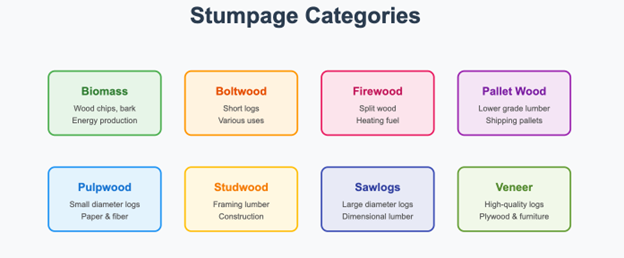It’s fascinating — we live in an age where data drives everything. Major decisions, billion-dollar strategies, even government policies hinge on the insights we draw from data. Yet there are still some formats which are still dependent on the traditional “Portable Document Format” (that’s the full-form “pdf”, just in case!), an area where the traditional is still a tradition and no one has tried bothering it. Until recently, I never gave this a second thought. But over the past two months, I found myself deep in a domain where PDFs still reign supreme — where digital dashboards and real-time analytics haven’t yet replaced age-old reporting practices.
What’s even more intriguing? This area has existed long before humans began building civilizations. A quiet category, rooted in nature itself, yet heavily tied to how we report and share its data today. Now let’s cut short the hype and peel the onion layer by layer.
Layer 1: The History

The state of Maine has a long history with forestry and the products associated with it. Its history is deeply intertwined with its forests, shaping its economy, culture, and landscape for centuries. But if we take a quick peek into the history, then for thousands of years, Indigenous peoples sustainably relied on Maine’s forests for canoes, shelter, and tools. European colonization began along the coast in the early 1600s, but settlement of the forested interior was slower—hindered by Native resistance and rugged terrain. After the American Revolution, settlers cleared millions of acres in southern and central Maine for farming, yet roughly 14–15 million acres remained largely forested due to limited development. The forest cover of Maine went from 60% in the 1950s due to agricultural clearing, but forest coverage has steadily increased to 89% today, making Maine the most forested state in the nation. Today, Maine has an estimated 17.5 million acres of forest land (83% of total area, 89% excluding water), with over 23 billion trees and forests that are 91% privately owned.
Layer 2: Maine’s Current Forest Landscape

Maine forests support over 23 billion living trees, covering more than 50 native species. Since, most forests are privately owned (over 90%), and are managed for diverse uses, including timber production, conservation, and recreation. Each year, thousands of acres are harvested, but also thousands revert to forest. As per the Maine Department of Agriculture, Conservation of Forestry, forest landowners who sell forest products or harvest for commercial use must submit a report stating the species, volume and stumpage price per unit of measure for each transaction.
Today Maine’s forest ecosystem is resilient and is growing healthier. The forests are dominated by two major forest-type groups: maple/beech/birch covering 7.2 million acres (41 percent) and spruce/fir covering 6.0 million acres (34 percent). Among hardwoods, red maple has taken the lead with remarkable expansion, followed by sugar maple, yellow birch, paper birch, and northern red oak. American beech still holds a presence but is declining due to beech bark disease. Other notable species include quaking aspen, bigtooth aspen, white ash, and several birch varieties. Beyond species composition, the numbers tell a story of progress—biomass is up 4%, annual tree growth has risen 18%, and thanks to conservation efforts, tree mortality has dropped to 13%.
In conclusion, the ecosystems remain diverse and complex—some tracts preserve old-growth legacies, while others reflect active regeneration processes but these trends indicate a forest in transition, with early successional species (paper birch, aspen) giving way to later successional species, while red maple continues its dramatic expansion across the landscape. The decline in commercially valuable species like sugar maple and northern white-cedar, coupled with the decline in American beech, presents significant management challenges for the future.
Layer 3: A Modern Tool for Forest Valuation

From 2000 to 2023, the Maine Department of Agriculture, Conservation and Forestry has been producing a goldmine of information through its Annual Stumpage Reports. Each year’s report isn’t just numbers on a page—it’s a snapshot of Maine’s timber economy. Inside, you’ll find data for eight distinct product classes—biomass, boltwood, firewood, palletwood, pulpwood, sawlogs, studwood, and veneer—broken down by major county, along with a year-end summary that ties it all together. Under each product class we have different species and its average price, minimum price, maximum price and number of reports collected.
The Maine Stumpage Dashboard represented a transformative leap, eliminating the time-consuming task of reviewing each year’s report to track price changes for any species across different counties. Built using R Shiny’s interactive framework, this comprehensive platform consolidates over two decades of stumpage pricing data (2000-2023). With the dashboard, users can seamlessly switch between different product classes and instantly view price trends based on their chosen county and tree species. Its dynamic visualization capabilities turn complex market data into clear, actionable insights—displaying average prices, inflation-adjusted values, and maximum and minimum price ranges through interactive time-series charts. The “connected scatterplot” unlocks relationships and market patterns that traditional tables could never reveal, while real-time filtering lets stakeholders drill down into specific market segments in seconds. Beyond pricing, the tool also chronicled county-level grouping changes since 2010 and documented the industry’s shift from cord-based to ton-based measurements between 2004 and 2023, capturing not just the numbers but the evolution of Maine’s timber markets.
In summary the R Shiny dashboard offers interactive visualizations that allow users to explore stumpage trends by species, region, time period, and product type. Users can compare current prices against historical averages. Whether analyzing spruce/fir sawlog trends in Aroostook County or comparing pulpwood values across the state, users can generate customized reports and export data for deeper analysis, making this tool essential for anyone engaged in Maine’s forest economy.
Conclusion
The Maine Stumpage Dashboard stands at the intersection of history and innovation—honoring centuries of Maine forest stewardship while equipping users with powerful data tools for a sustainable future. Historically, stumpage pricing has been opaque, with values varying widely, the dashboard democratizes access to market information, enabling smaller landowners to negotiate fairly and make informed management decisions. By providing clear economic data, the dashboard helps landowners understand the opportunity costs of conservation decisions. This transparency supports programs that compensate landowners for ecosystem services like carbon sequestration, wildlife habitat, and watershed protection.
Maine’s forests have proven remarkably resilient through four centuries of change. With modern tools like the Stumpage Dashboard, we can ensure they continue to provide economic, ecological, and social benefits for centuries to come. The dashboard isn’t just about tracking timber prices – it’s about sustaining the communities, ecosystems, and ways of life that depend on Maine’s extraordinary forest legacy.
References
- Maine stumpage price reports, 2000-2023
- Maine History Online
- Reconstructing the past: Maine forests then and now
- Forests of Maine, 2021 (USDA Forest Service)
- Maine Forests 2018: summary report (USDA Forest Service)
–
By Tejas Phanse, Innovate for Maine Fellow with Arbor Analytics. Summer 2025.